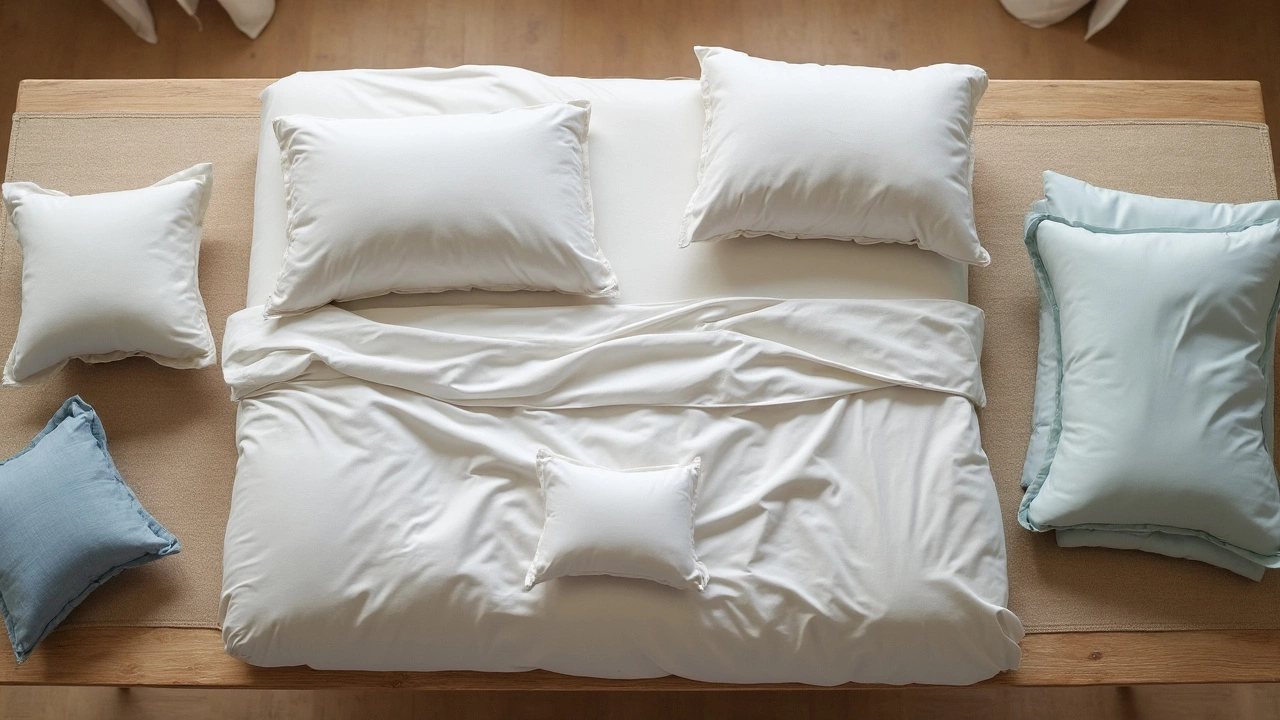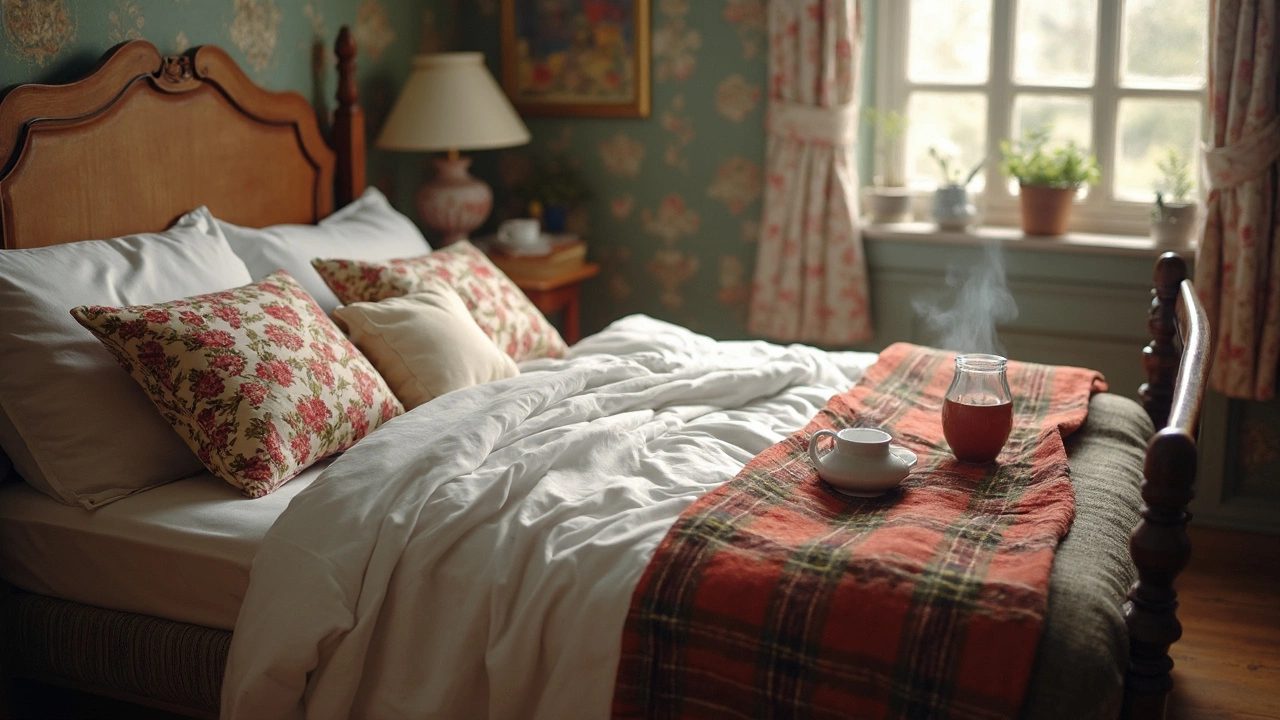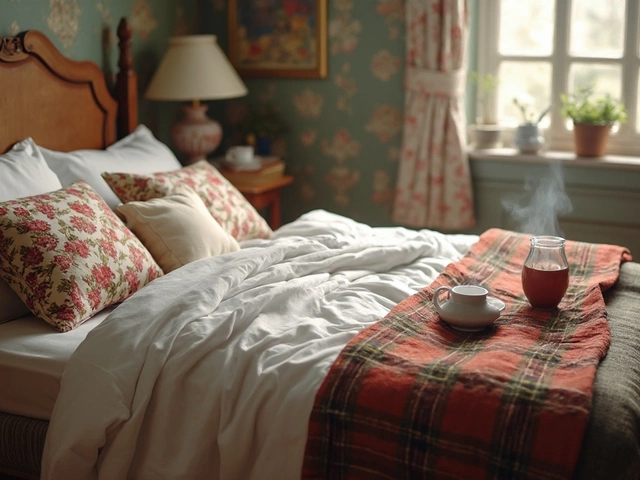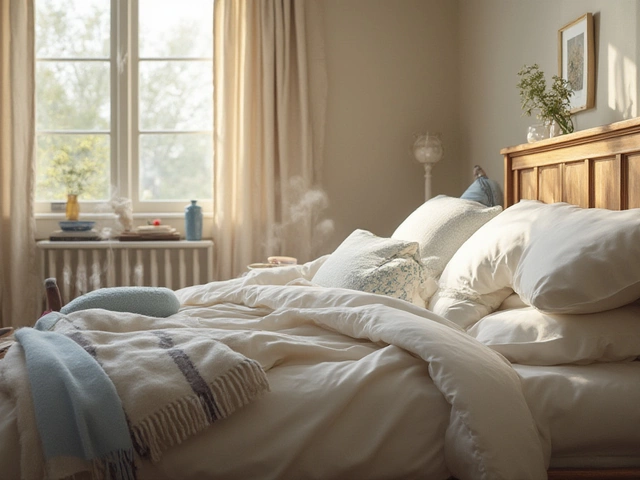Ever stood in a store or scrolled online and wondered if 'bed linen' and 'bedclothes' are just fancy ways to say 'bedding'? Turns out, they pretty much are. People use all sorts of words for the stuff you put on your mattress—sheets, pillowcases, comforters, duvet covers, even quilts. In the UK, you’ll hear “bed linen” more often, while in the US, “bedding” or “bedclothes” shows up. If it’s fabric and it goes on the bed, it probably falls under one of those names.
It’s not just about the words though. Some folks call the whole set “bedding,” but others break it down—like saying “sheet set” when they mean only the fitted and flat sheets plus pillowcases. “Bed linen” isn’t always linen either—most of it is cotton or microfiber these days. Getting familiar with the terms makes shopping for a cozy bed way less confusing, and it saves you from accidentally buying just a sheet when you wanted the whole shebang!
- Bedding: A Bunch of Different Names
- What's Included in Bedding Sets
- Materials That Matter
- Fun Facts About Bedding
- How to Pick the Right Bedding
- Tips to Make Your Bedding Last
Bedding: A Bunch of Different Names
Walk into any bedding store, and you’ll notice there are a bunch of words that basically mean the same thing. Bedding is the all-encompassing term, but there are a few others that you’ll run into, depending on where you live or who you’re talking to.
In the UK and Australia, people say “bed linen” a lot. Over in the US, you’ll probably hear “bedclothes” or “bed sets.” Most people use “sheets” to mean everything, though technically a bed needs more than just sheets. On packaging, “sheet set,” “comforter set,” or “duvet cover set” pop up, especially when you’re buying everything together. When hotels list their amenities, they’ll mention “linens” to include your sheets, pillowcases, and sometimes towels.
The list of alternate names for bedding can include:
- Bed linen
- Bedclothes
- Bed sheets
- Bedsheets (yes, as one word)
- Bedcoverings
- Linens
- Sleep set (pretty rare, but it shows up in catalogs sometimes)
Some of these are old-school, but brands still use them, especially high-end ones that want to sound fancy. If you’ve shopped online, you might have noticed filters for things like “duvet covers,” “quilts,” “mattress toppers,” and “comforters.” They all fall under the big bedding umbrella.
Here’s a quick snapshot of what these terms mean around the world:
| Region | Common Names |
|---|---|
| United States | Bedding, bedclothes, sheets, comforter set |
| United Kingdom | Bed linen, duvet cover set, sheets |
| Australia | Bed linen, quilts, doona set |
| Canada | Bedding, bed linen, comforter set |
Here’s a tip: when you’re searching online, try both “bed linen” and “bedding” to see all the available options. If you spot the word “linens,” it usually means the main sheet stuff and not blankets or covers, but sometimes even towels get tossed in. Clarity helps you get exactly what you want instead of a few pillowcases when what you were after was an entire set.
What's Included in Bedding Sets
If you’re shopping for bedding sets, you’ll notice there’s a lot more to the package than just sheets. A standard bedding set usually includes a fitted sheet (the stretchy one with corners that hugs your mattress), a flat sheet (the one you lay on top or under the comforter), and pillowcases. That’s the basic starter pack in most stores.
Go a little fancier, and you’ll get a comforter or a duvet cover included. Some sets tag on a coverlet, bed skirt, or even an extra set of pillow shams for those ‘magazine bed’ vibes. In the UK, “bed linen sets” might skip the flat sheet completely, especially since duvets are more common there.
Here’s a quick list of what you might find in a bedding bundle:
- Fitted sheet
- Flat sheet
- Pillowcase(s)
- Comforter or duvet cover
- Pillow shams
- Bed skirt
Some brands offer a “bed-in-a-bag” setup. This usually packs up everything you need—sometimes even decorative pillows—so you can completely redo your bed in one go. Just check the product details, because sizes and contents can really differ. Twin sets usually come with one pillowcase, while queen and king sets have two. If you want the whole look, buying a bedding set simplifies shopping and often saves you some cash compared to picking things out one by one.
And if you see the term bedding on a package, expect it to cover most or all of the above. It's the catch-all word stores use, and knowing what’s normally included helps you avoid surprises (like realizing you’re missing a pillowcase when you get home).
Materials That Matter
No one wants scratchy or sweaty sheets, right? That’s why the stuff your bedding is made from makes a real difference in how you sleep. The classic choice is cotton, mainly because it’s soft, breathable, and holds up well after tons of washes. You might see labels like 'Egyptian cotton' or 'Pima cotton'—those types have longer fibers, which means your sheets will probably feel smoother and last longer.
Then there's microfiber, which is made from super thin polyester threads. Microfiber sheets are known for being budget-friendly, wrinkle-resistant, and pretty easy to clean. They're great for people who want low-maintenance without breaking the bank. Some folks find them a bit less breathable, though, especially in hot weather.
Another option is linen. Linen bedding is super durable and pulls away heat and moisture, so it feels cool if you run hot at night. The only catch? Linen wrinkles more, and it usually costs more upfront, but those sheets can last for years—sometimes getting softer the more you use them.
Silk sounds fancy, and it kind of is, but people love silk pillowcases for helping with hair frizz and skin. They’re smooth, but real silk is delicate and needs extra care. Flannel is the opposite—a winter favorite, made from brushed cotton that feels extra warm and snuggly.
| Material | Main Benefit | Downside | Best For |
|---|---|---|---|
| Cotton | Soft, breathable, durable | Can wrinkle | Everyday bedding |
| Microfiber | Cheap, easy to care for, wrinkle-free | Less breathable | Kids, guests, convenience |
| Linen | Cool, durable, moisture-wicking | Wrinkles easily, pricier | Hot sleepers, luxury |
| Silk | Smooth, good for skin and hair | Needs special care, expensive | Beauty-focused, luxury |
| Flannel | Warm, cozy | Too hot for summer | Cold climates |
When you’re picking out bedding, think about whether you value pure comfort, easy care, or temperature control. If allergies are your issue, check for hypoallergenic labels—certain cotton and microfiber options are made to help with that. There’s no one-size-fits-all answer, but knowing your options saves you from a lot of trial and error—and helps you wake up a little happier every morning.

Fun Facts About Bedding
Bedding isn’t just about looks or comfort—there’s a ton of neat trivia behind the stuff we sleep on. Did you know ancient Egyptians used linen sheets as early as 3000 BC? They believed linen was pure and helped beat the heat at night.
The world’s largest bed, built in the Netherlands, is about 87 feet long and 54 feet wide! That’s nearly as big as a bowling lane. Most of us aren’t aiming for world records, but it’s wild to think about how far bedding has come.
Here’s a quick look at some surprising facts and numbers:
| Fact | Detail |
|---|---|
| Most common bedding material | Cotton (used in about 60% of sheets sold worldwide) |
| Average sheet washing frequency (US) | About once every 2 weeks |
| Thread count sweet spot | Between 300–500 (anything higher is usually marketing) |
Some cultures have unique bedding customs. In Japan, people use futons that are folded and put away every morning. Scandinavian countries love the idea of having two duvets on one bed—so each person gets their own cover and no one steals the blankets at night.
Here’s what the folks at the Sleep Foundation have to say about the right kind of bedding:
"Choosing quality bedding improves your sleep by regulating temperature and ensuring comfort all night long."
If you see ‘Egyptian cotton’ or ‘Pima cotton’ on a label, it usually means the sheets are softer and can withstand way more washes. Fun fact: the world record for fastest bed-making is 74 seconds, set by two hospital employees in England. Not that you need to hurry, but hey, a little challenge never hurts!
How to Pick the Right Bedding
Choosing the best bedding doesn’t have to feel like a chore. The right set can mean the difference between a restless night and that feeling of being wrapped in a comfy cloud. Here’s what really matters when you’re deciding what to buy:
- Material matters. Cotton is still the winner—about 60% of sheets sold in the US are cotton, thanks to its breathability and easy care. If you want something cheaper and wrinkle-resistant, microfiber is everywhere. Linen feels cool and luxurious, but it wrinkles more easily and usually costs a bit more.
- Thread count isn’t everything. Higher numbers sound fancy but anything between 200 and 400 for cotton usually does the trick. Super high thread counts can feel stiff or even trap heat.
- Weave affects feel. Percale gives that crisp, hotel-sheet vibe, while sateen is smoother and a little heavier. Jersey weave? Think T-shirt softness. Flannel's your go-to for cold nights.
- Size and fit count. Measure your mattress before you buy. Deep-pocket sheets fit taller mattresses (especially if you have a topper).
- Allergies? Hypoallergenic options are labeled for a reason—look for bedding made from bamboo, TENCEL, or special coated cotton to keep dust mites and allergens away.
Take a look at this quick comparison table to see what’s common in bedding shopping:
| Material | Feels Like | Best For | Care |
|---|---|---|---|
| Cotton | Crisp or soft & breathable | Everyday use | Easy—machine wash & dry |
| Microfiber | Light, smooth, wrinkle-free | Budget, low-maintenance | Very easy |
| Linen | Cool, textured, airy | Warm climates, luxury feel | Gets softer, but wrinkles |
| Flannel | Warm, fuzzy, cozy | Winter and cold sleepers | Wash warm, avoid hot dryer |
Don’t get caught up in labels and jargon. Think about what feels good to you, your budget, and your laundry habits. One more tip: sets aren’t always the cheapest way—sometimes buying top sheets, fitted sheets, and pillowcases separately lands you exactly what you want for less.
Tips to Make Your Bedding Last
If you want your bedding to stay comfy and look good for years, it's not just about picking the right set—it's about how you care for it. Most people don't realize that tiny habits, like how often you wash your sheets, can make a huge difference in how long they last.
Here's what actually keeps bedding in great shape:
- Wash regularly, but not too much: Once a week is a sweet spot for most folks. Washing too often can wear out the fibers, but waiting too long lets sweat and oils break down the fabric.
- Use cold or warm water: Hot water fades colors and can shrink your sheets. Stick to cold or warm settings to keep everything smooth and true-to-size.
- Skip harsh detergents and bleach: Go for mild detergent. Bleach and strong cleaners eat away at fabric and seriously shorten its life.
- Dry right: Tumble dry on low or air dry if you can. High heat weakens fibers and can turn your pillowcases into something you'd rather not sleep on.
- Rotate your sets: Owning two or three sets and rotating them lets each set rest between washes. This spreads out the wear and helps all your linen last longer.
- Don't overpack the washer: Overstuffing the machine means bedding doesn't get clean, and it strains the seams and elastic on fitted sheets.
Worried about when to replace your sheets? Here's a quick comparison of average lifespans, based on fabric:
| Material | Average Lifespan |
|---|---|
| Cotton | 2-4 years |
| Microfiber | 2-3 years |
| Linen | 3-5 years |
| Bamboo | 2-3 years |
| Silk | 1-2 years |
One more thing—think about the pillowcases. Since they soak up the most oil from your face and hair, swapping them out every couple of nights helps both your skin and your sheets last way longer. Bottom line: treat your bedding well, and you’ll sleep better (and save money on replacements).



